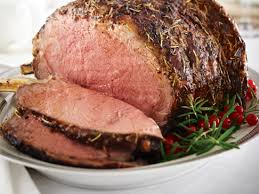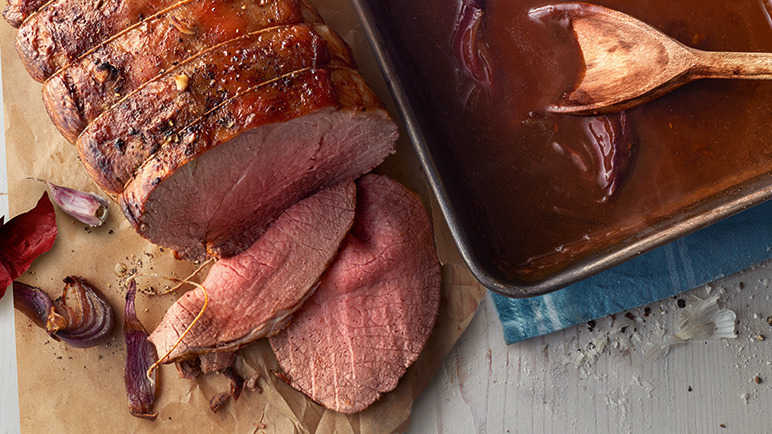I don't think there is a better known British meal than Roast Beef. I think you could perhaps call it the national dish of Great Britain and loved by almost everyone. But is there a good or better way to cook the perfect roast beef. It is actually very easy as you can see with these handy tips below.

1. Choosing the Beef:
The best joints for roast beef are either a Rib of Beef, a Sirloin or a Fillet. Rib works well as usually it will be cooked on the bone as keeping the bone in makes for a tastier piece of beef when cooked but both Sirloin and Fillet are also very good.
The beef should be:
Dark in colour - meaning it has been hung well and is mature.
A thick covering of fat which adds flavor and prevents the joint from drying out during cooking. This layer can be removed, if required, before serving so no need to worry too much about excess fat.
Marbling: Marbling is small slivers of fat running through the flesh which again adds flavour and prevents drying out during cooking.
2. How Much to Buy:
5½ lb/2.5kg bone in will feed 6
3 lb/1.5kg boned will feed 6
Don't worry about buying too much as cold roast beef can be added to a plate of cold cuts with a salad.
3. Cooking Temperature:
There are varying opinions about what the perfect temperature to cook a roast beef but you may find that starting the beef in a very hot oven 425F/220C/Gas 7 for the first 30 mins then lower the temperature to 375F/190C/Gas 5 for the remaining cooking time then ....how long to cook beef depends on your preference for how 'pink' or not you like to eat beef.
Calculate:
Rare - 11 mins per lb/450g
Medium - 14 mins per lb/450g
Well done - 16 mins per lb/450g
These times are based on a normal convection oven, you may want to adjust for a fan oven according to the manufacturers instructions. Another way to work out the cooking time is to use a meat thermometer pushed into the thickest part of the beef.
60°C/140°F - rare
70°C/160°F- medium
80°C/175°F - well done
4. How to Cook:
The beef should be at room temperature. Stand the beef joint in a roasting tin then cook to the temperature and time as above.
5. Rest, Rest, Rest:
An important part of cooking any meat is once it is removed from the oven the meat must rest. Wrap the meat loosely in aluminum foil and put to one side.
The fibers in meat tighten up during cooking and resting allows the fibers to relax, release some of the meat juices (great for the gravy) and results in a soft tender piece of meat. 20 minutes should be long enough but up to an hour won't do any harm. The joint is then ready to carve.

Tips taken from original article here
http://britishfood.about.com/od/introtobritishfood/a/roastbeef.htm
I put this article on the Low Carb Blog and if you 'hop' over and have a read of the comments - there is also some handy tips for some low carb yorkshire pudding
http://thelowcarbdiabetic.blogspot.co.uk/2015/06/roast-beef-such-very-traditional-meat.html
All the best Jan

1. Choosing the Beef:
The best joints for roast beef are either a Rib of Beef, a Sirloin or a Fillet. Rib works well as usually it will be cooked on the bone as keeping the bone in makes for a tastier piece of beef when cooked but both Sirloin and Fillet are also very good.
The beef should be:
Dark in colour - meaning it has been hung well and is mature.
A thick covering of fat which adds flavor and prevents the joint from drying out during cooking. This layer can be removed, if required, before serving so no need to worry too much about excess fat.
Marbling: Marbling is small slivers of fat running through the flesh which again adds flavour and prevents drying out during cooking.
2. How Much to Buy:
5½ lb/2.5kg bone in will feed 6
3 lb/1.5kg boned will feed 6
Don't worry about buying too much as cold roast beef can be added to a plate of cold cuts with a salad.
3. Cooking Temperature:
There are varying opinions about what the perfect temperature to cook a roast beef but you may find that starting the beef in a very hot oven 425F/220C/Gas 7 for the first 30 mins then lower the temperature to 375F/190C/Gas 5 for the remaining cooking time then ....how long to cook beef depends on your preference for how 'pink' or not you like to eat beef.
Calculate:
Rare - 11 mins per lb/450g
Medium - 14 mins per lb/450g
Well done - 16 mins per lb/450g
These times are based on a normal convection oven, you may want to adjust for a fan oven according to the manufacturers instructions. Another way to work out the cooking time is to use a meat thermometer pushed into the thickest part of the beef.
60°C/140°F - rare
70°C/160°F- medium
80°C/175°F - well done
4. How to Cook:
The beef should be at room temperature. Stand the beef joint in a roasting tin then cook to the temperature and time as above.
5. Rest, Rest, Rest:
An important part of cooking any meat is once it is removed from the oven the meat must rest. Wrap the meat loosely in aluminum foil and put to one side.
The fibers in meat tighten up during cooking and resting allows the fibers to relax, release some of the meat juices (great for the gravy) and results in a soft tender piece of meat. 20 minutes should be long enough but up to an hour won't do any harm. The joint is then ready to carve.

Tips taken from original article here
http://britishfood.about.com/od/introtobritishfood/a/roastbeef.htm
I put this article on the Low Carb Blog and if you 'hop' over and have a read of the comments - there is also some handy tips for some low carb yorkshire pudding
http://thelowcarbdiabetic.blogspot.co.uk/2015/06/roast-beef-such-very-traditional-meat.html
All the best Jan




